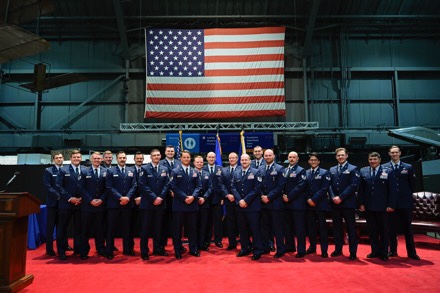
Chaos.
In one word, that’s how the U.S. Air Force AC-130J gunship crews of Shadow 77 and Shadow 78 described the scene of Kabul, Afghanistan, on Aug. 15, 2021.
“There were just cars and people everywhere trying to get on to the airfield,” said 1st Lt. William Bachmann, copilot on board Shadow 78.
For the crews of Shadow 77 and 78, the mission to support the U.S. withdrawal from Afghanistan would go on to last nearly 30 hours combined – resulting in the evacuation of roughly 2,000 Americans.
Those members of the 73rd Special Operations Squadron were honored for their efforts as recipients of the 2021 MacKay Trophy during a ceremony at the National Museum of the U.S. Air Force at Wright-Patterson Air Force Base, Ohio, Dec. 7, 2022.
The trophy, which is administered by the Air Force and the National Aeronautic Association for the “most meritorious flight” of the year by an Air Force person or organization, was presented to the crew by U.S. Air Force Vice Chief of Staff of the Air Force, Gen. David Allvin, alongside Greg Principato, NAA President.
“Shadow 77 and Shadow 78 – you own, now, a special place,” said Allvin. “Your name is on the same board with the greats…there’s not many that can say that. You earned your way onto that by being the best Airmen that you could when the nation called upon you.”
Not a matter of “if” but “when”
In the days and weeks leading up to Aug. 15, the gunship crews tracked the latest updates as Taliban forces made advances throughout Afghanistan.
At the time, the members of the 73rd SOS at Hurlburt Field, were deployed to Al Dhafra Air Base in the United Arab Emirates.
The crews remained on standby to support the U.S. withdrawal.
“[We knew] it was going to happen at some point and that we were definitely going to be part of it,” said Bachmann. “It was surreal.”
On the morning of Aug. 15, the team assigned to Shadow 77 woke up to a notification telling them to report earlier than planned.
Capt. Lawrence Bria, aircraft commander of Shadow 77, said the crews had just enough time to quickly grab food, before heading to the gunship to get ready for takeoff.
“We didn’t know how long the night was going to go,” Bria said. “But, as we flew toward Afghanistan, we talked about how we were going to be there as long as we needed to be and as long as leadership would allow us to be there.”
As the gunship approached Kabul, they could see celebratory gunfire from the Taliban, as well as fireworks in the distance.
Upon arrival, Shadow 77’s initial mission was to provide overhead support as helicopter crews worked to evacuate the embassy and transport Americans to Kabul’s Hamid Karzai International Airport.
Shortly after, Shadow 78 arrived on scene to assist in the evacuation efforts.
Ultimately, the crews on board Shadow 77 and Shadow 78 served as “eyes in the sky,” Bria explained.
“We were there in case things went even worse and a threat came to the Americans, either at the embassy or on the airfield, we would be there, ready for it,” he said.
A highly modified aircraft, the AC-130J is used to perform close air support, air interdiction and armed reconnaissance missions. Unique to this gunship in particular, the AC-130J features a precision strike package that includes 30mm and 105mm weapons.
Additionally, the gunship is equipped with non-lethal, overt lasers that can be used for crowd control and to deter violence.
This feature in particular became helpful as chaos broke out on the airfield, Bria noted.
“During the rush toward the airfield, we were able to use the spotlight to help friendly forces on the ground,” Bria explained. “If we saw anyone try to jump the fence or make a break for it on the runway, we used it to help ground forces to stop them.”
Their crowd dispersion efforts allowed eight U.S. Air Force C-17 Globemaster III aircraft to land and take off from Hamid Karzai International Airport – carrying the Americans and Afghan refugees to safety.
In total, Shadow 77 and 78 executed a 29.8-hour mission – with Shadow 77 flying the longest unaugmented AC-130J flight to date at 15.7 hours.
And while the mission lasted longer than some may have expected, Bria said the crews simply fell back on their training to push through.
“At that point, your instincts just kick in to make sure the Americans on the ground are safe, and you push your exhaustion and your stress and your worries to the side to get the mission done,” Bria said.
Air Force history
Each of the 18 crew members received a medallion to commemorate their selection for the prestigious award.
During the ceremony, Air Force Special Operations Deputy Commander, Maj. Gen. Matthew Davidson lauded the crews for their “relentless” commitment to the mission’s success.
“Shadow 77 and Shadow 78 have earned their spot on an incredible list of Airmen that are historic in our Air Force,” said Davidson. “America’s competitive advantages are these Airmen and those hundreds of thousands [of] others that are out there. No adversary will ever compete with the Airmen that the United States Air Force will put on the battlefield.”
Following the presentation, the trophy will return to its permanent display at the Smithsonian’s National Air and Space Museum in Washington, D.C.
For the crews of Shadow 77 and 78, the award serves as recognition for all of the forces involved in the mission, Bachmann said.
“I wish that we could give it to every crew that was out there,” he said. “Everyone that was involved should take pride in this trophy being awarded in recognition of that mission.”
By Airman 1st Class Natalie Fiorilli, 1st Special Operations Wing Public Affairs

